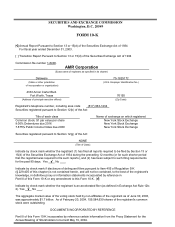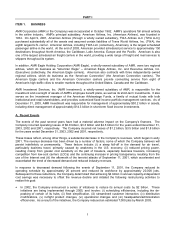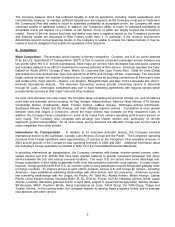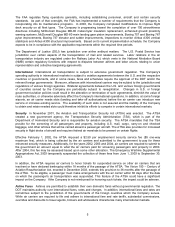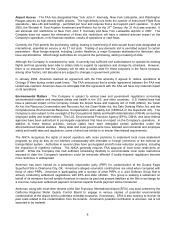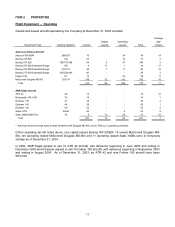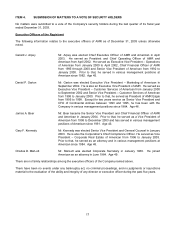American Airlines 2003 Annual Report Download - page 11
Download and view the complete annual report
Please find page 11 of the 2003 American Airlines annual report below. You can navigate through the pages in the report by either clicking on the pages listed below, or by using the keyword search tool below to find specific information within the annual report.
9
The impact of fuel price changes on the Company and its competitors depends on various factors, including
hedging strategies. The Company has a fuel hedging program in which it enters into jet fuel, heating oil and crude
oil swap and option contracts to dampen the impact of the volatility of jet fuel prices. During 2003, 2002 and 2001,
the Company’s fuel hedging program reduced the Company’s fuel expense by approximately $149 million, $4
million and $29 million, respectively. As of December 31, 2003, the Company had hedged, with option contracts,
approximately 21 percent of its estimated first quarter 2004 fuel requirements, 16 percent of its second quarter
2004 estimated fuel requirements and six percent of its estimated fuel requirements for the remainder of 2004.
The Company’s credit rating, as discussed in Liquidity and Capital Resources under Item 7, has limited its ability to
enter into certain types of fuel hedge contracts. A further deterioration of its credit rating or liquidity position may
negatively affect the Company’s ability to hedge fuel in the future. See the Risk Factors under Item 7 for
information regarding fuel.
Additional information regarding the Company’s fuel program is also included in Item 7(A) – Quantitative and
Qualitative Disclosures about Market Risk and in Note 7 to the consolidated financial statements.
F. Frequent Flyer Program
American established the AAdvantage frequent flyer program (AAdvantage) to develop passenger loyalty by
offering awards to travelers for their continued patronage. The Company believes that the AAdvantage program is
one of its competitive strengths. AAdvantage members earn mileage credits for flights on American, American
Eagle and certain other participating airlines, or by using services of other program participants, including bank
credit card issuers, hotels, car rental companies and phone service companies. American sells mileage credits
and related services to the other companies participating in the program. American reserves the right to change
the AAdvantage program at any time without notice and end the program with six months notice.
Mileage credits can be redeemed for free, discounted or upgraded travel on American, American Eagle or
participating airlines, or for other travel industry awards. Once a member accrues sufficient mileage for an award,
the member may book award travel on American. Most travel awards are subject to capacity controlled seating.
Mileage credit does not expire, provided a customer has any type of qualifying activity at least once every 36
months.
American uses the incremental cost method to account for the portion of its frequent flyer liability incurred when
AAdvantage members earn mileage credits by flying on American or American Eagle. American's frequent flyer
liability is accrued each time a member accumulates sufficient mileage in his or her account to claim the lowest
level of free travel award (25,000 miles) and the award is expected to be used for free travel. American includes
fuel, food, and reservations/ticketing costs in the calculation of incremental cost. These estimates are generally
updated based upon the Company’s 12-month historical average of such costs. American also accrues a frequent
flier liability for the mileage credits that are expected to be used for travel on participating airlines.
Revenue earned from selling AAdvantage miles to other companies is recognized in two components. The first
component represents the revenue for air transportation sold and is valued at current market rates. This revenue
is deferred and recognized over the period the mileage is expected to be used, which is currently estimated to be
28 months. The second revenue component, representing the marketing products sold and administrative costs
associated with operating the AAdvantage program, is recognized immediately.
At December 31, 2003 and 2002, American estimated that approximately 9.3 million free travel awards were
expected to be redeemed for free travel on American and American Eagle. In making the estimate of free travel
awards, American has excluded mileage in inactive accounts, mileage related to accounts that have not yet
reached the lowest level of free travel award, and mileage in active accounts that have reached the lowest level of
free travel award but which are not expected to ever be redeemed for free travel on American or participating
airlines. The Company’s total liability for future AAdvantage award redemptions for free, discounted or upgraded
travel on American, American Eagle or participating airlines and unrecognized revenue from selling AAdvantage
miles to other companies was approximately $1.2 billion (and is recorded as a component of Air traffic liability in
the consolidated balance sheets), representing 18.8 percent and 16.2 percent of AMR's total current liabilities, at
December 31, 2003 and 2002, respectively.


